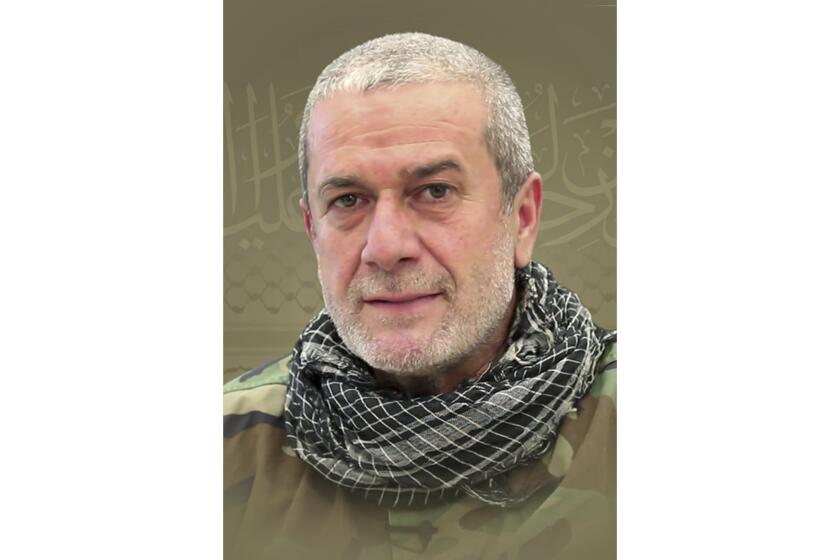Israeli strike in Syria kills a former bodyguard of Lebanon’s Hezbollah leader

- Share via
BEIRUT — An Israeli strike in Syria on Tuesday killed a former bodyguard of the leader of the Lebanese militant group Hezbollah, an official with the group said. An Israeli man and woman were killed in a retaliatory Hezbollah strike on Israel.
Hours earlier, an Israeli drone hit a car in Syria near the border with Lebanon, according to a war monitor and the Syrian pro-government radio Sham FM. The Hezbollah official spoke on condition of anonymity in line with regulations.
The Britain-based pro-opposition war monitor Syrian Observatory for Human Rights said two members of Hezbollah in the car were killed in the strike, while a Syrian driver was critically wounded. There was no immediate comment from Syrian authorities or from the Israeli military.
Hezbollah later identified one of the militants as Yasser Nemr Qranbish, although they did not disclose the details of his death. That’s standard practice for Hezbollah combatants who aren’t in leadership roles.
Hezbollah supporters mourned his death on social media, calling him the “shield of the Sayyed,” in reference to his tenure as a bodyguard of Hezbollah’s leader Hassan Nasrallah.
Later Tuesday, Hezbollah announced that in retaliation for the killing, it fired tens of Katyusha rockets targeting an Israeli military base in the Golan Heights. Israeli police said in a statement that a man and a woman were killed in the rocket barrage. The MADA rescue service said they were civilians.
Qranbish had been mainly active in Syria in recent years and involved in weapons shipments for Hezbollah, said an official with an Iran-backed group, who also spoke on condition of anonymity to disclose the information.
Since the war in Gaza began, Israeli airstrikes on Lebanon have killed over 450 people, mostly Hezbollah fighters but also more than 80 civilians and non-combatants. On the Israeli side, 17 soldiers and 13 civilians have been killed.
The deadly strike in southern Lebanon comes as tensions continue to boil and diplomats scramble for calm.
Tens of thousands of people on both sides of the tense Lebanon-Israel frontier have been displaced in the months-long war.
For years, Israel has launched frequent strikes on targets in Syria linked to Iran, its powerful regional backer, but rarely acknowledges them. The strikes have escalated over the last five months against the backdrop of the war in Gaza and ongoing clashes between Hezbollah and Israeli forces on the Lebanon-Israel border.
Hezbollah’s attacks have gradually escalated, with the group introducing new weapons. Hezbollah maintains it will stop its attacks once there is a cease-fire in Gaza. Israel has also struck deeper into Lebanon.
The targeting of Qranbish appears to be part of an ongoing Israeli military strategy of taking out key Hezbollah operatives aimed at weakening its military capabilities “before any major escalation that might” follow, said Charles Lister of the Washington-based Middle East Institute think tank.
“That it occurred in Syria will serve as another potent reminder of Israel’s clear penetration of the ‘resistance axis’ there,” Lister told the Associated Press, referring to the regional network of Iran-backed groups.
Also Tuesday, Hezbollah released drone footage over the Israeli-annexed Golan, identifying Israeli military bases and strategic areas.
Soon after, Israeli Foreign Minister Israel Katz said in a post on X that Hezbollah’s Nasrallah would be “considered the destroyer of Lebanon” if the Iran-backed group does not end its threats and attacks and withdraws from southern Lebanon.
Mroue and Chehayeb write for the Associated Press. AP writers Sarah El Deeb in Beirut and Natalie Melzer in Jerusalem contributed to this report.
More to Read
Sign up for Essential California
The most important California stories and recommendations in your inbox every morning.
You may occasionally receive promotional content from the Los Angeles Times.











